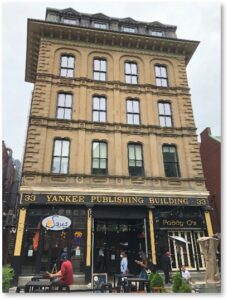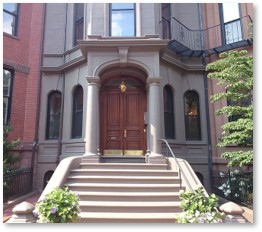The most historic and often-photographed building on Boston’s Union Street is, of course, the Union Oyster House. That’s not the subject of today’s post, though. Typically, I avoid writing about Boston’s most popular and historic structures. You can find them—and only them—in any guidebook to the city.
The Lesser-Known Buildings
I prefer to focus on the lesser-known structures that people often don’t notice or take for granted. That approach brings its own challenges. When I turn to my shelves of books about the city, its streets, buildings, gardens, and events, I may find no reference to the building in which I am interested. This happened, for example, with my post about the Farlow Building on State Street.
 That dearth of information forces me to the internet, which can provide data that’s sometimes inaccurate or anecdotal. When I was writing an article for Atlas Obscura on the men’s comfort station that turned into a sandwich shop on Boston Common, I kept finding the same information in exactly the same sentences. Someone had written a history that was clearly incorrect but many sites had scraped it from the web verbatim and proliferated it.
That dearth of information forces me to the internet, which can provide data that’s sometimes inaccurate or anecdotal. When I was writing an article for Atlas Obscura on the men’s comfort station that turned into a sandwich shop on Boston Common, I kept finding the same information in exactly the same sentences. Someone had written a history that was clearly incorrect but many sites had scraped it from the web verbatim and proliferated it.
What to do? I turned from researching the comfort station to the architect and found what I needed. All it took was an indirect approach.
Union Street and the Blackstone Block
Today, I decided to talk about the Yankee Publishing Building at 33 Union Street. As expected, my reference books—and I have many—offered nothing.
 Alrighty, then, let’s start with the street. Union Street, laid out in 1636, runs along the western side of the Blackstone Block from North Street to Hanover Street. The Blackstone Block is Boston’s oldest commercial district and the only part of the city that retains its original street pattern. (Notice I did not say “street plan.” There is nothing planned about the Blackstone Block, which contributes to its charm.)
Alrighty, then, let’s start with the street. Union Street, laid out in 1636, runs along the western side of the Blackstone Block from North Street to Hanover Street. The Blackstone Block is Boston’s oldest commercial district and the only part of the city that retains its original street pattern. (Notice I did not say “street plan.” There is nothing planned about the Blackstone Block, which contributes to its charm.)
Originally Union Street held the usual assortment of descriptive and geographical names including Green Dragon Lane. It was changed to Union Street in 1708 in honor of the formation of the British Union under Queen Anne.
This area held many retail shops run by artisans, many of whose wares supported the shipping industry, and whose shops occupied the front rooms of their homes. On Pope Night, Union Street was where the two warring factions of fractious young men brought their effigies of popes and devils, and where they fought with fists, sticks, and stones to capture the pope of the other side.
The Yankee Publishing Building
The Yankee Publishing Building at #33 Union Street once housed the publishers of Yankee Magazine, now headquartered in Dublin, NH. For more information on when it was constructed and for whom, I turned to my usually reliable sources: commercial real estate and apartment listings. Those online listings existed but with darned few details. The Buildings of New England blog’s post on Yankee Publishing Building / 1874 provided more historical data.
Number 33 Union Street was bult in 1874 for Cyrus Carpenter (1821-1893) to house sales for his coal stove and furnace company. He founded the company in 1840 when he was only 19 years old. Mr. Carpenter overcame some financial setbacks and apparently declared bankruptcy at one point. Nevertheless, he paid his debts “100 cents on the dollar.”
For some reason, perhaps financial, he then moved his company to 44 Hanover Street and rented the new building on Union Street to a competitor, Walker and Pratt Manufacturing Company.
 His wife inherited the structure after Mr. Carpenter was run over by a Back Bay horse car and killed instantly at the corner of Arlington and Boylston Streets. She sold it to the existing tenants, who continued to market their goods from the shop with their offices above.
His wife inherited the structure after Mr. Carpenter was run over by a Back Bay horse car and killed instantly at the corner of Arlington and Boylston Streets. She sold it to the existing tenants, who continued to market their goods from the shop with their offices above.
The Back Bay Connection
If the unfortunate Mr. Carpenter met his end in the Back Bay, I thought, perhaps he lived there. I checked my sources on that one, including the amazingly comprehensive backbackhouses.org, and found his name at 17 Marlborough Street. He purchased the home on July 3, 1886, from George Howe and lived there with his first wife, Rebecca (King) Carpenter.
She died in September of 1890, and the following year he married Mrs. Ellena E. (Green) Fuller, the former wife of Dean Fuller. She was a vocalist. The second Mrs. Carpenter sold the home four months after her husband’s unfortunate encounter with the horse car,
The Building at 33 Union Street
After all this research, I can tell you that 33 Union Street, built in 1874, is a five-story building with a granite facade and corner quoining and a Mansard roof. A restaurant on the left of the entrance and an Irish bar on the right anchor the first floor. The upper levels are residential. Oh, and it’s located on the other side of Marshall Lane from the Union Oyster House.
Despite some (ahem) digging, I have not been able to find Cyrus Carpenter’s final resting place but I hope it’s far away from any horses.


